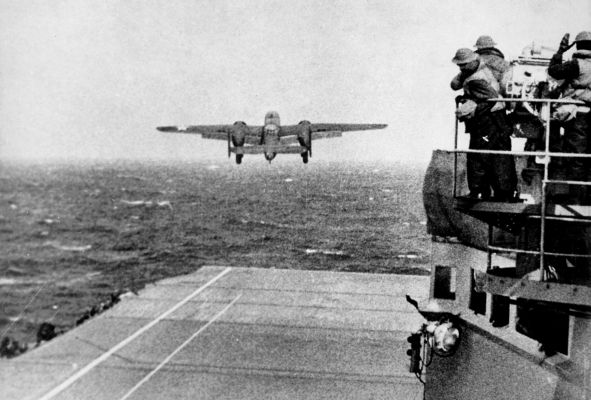



Posted on 03/13/2006 3:56:14 PM PST by SandRat
3/13/2006 - U.S. AIR FORCE ACADEMY, Colo. (AFPN) -- Two aviators who brought World War II to the Japanese mainland, and the daughter of the mission’s leader, will speak at the Air Force Academy March 14.
Retired Cols. Bill Bower and Dick Cole, along with Jonna Doolittle-Hoppes are the speakers for a lectinar here sponsored by the Academy’s history department.
On April 18, 1942, 80 volunteer bomber aircrews led by then-Lt. Col. James Doolittle launched 16 B-25 Mitchell medium bombers from the USS Hornet, to bomb mainland Japan.
Colonel Cole and Doolittle were at the controls of the first bomber to take off from the aircraft carrier. Their destination was Tokyo. They dropped incendiary bombs near an armory, then made a low-level escape west to China, bailed out, met up with Chinese forces and returned to friendly territory.
This mission was the first American strike on the Japanese mainland. It also gave America a much-needed morale boost during the early days of World War II, and showed how unprepared the Japanese mainland was for air attacks.
“Nearly every plane, on its approach to Japan, has reported the sighting of naval and merchant vessels, innumerable small fishing craft, and a number of patrol planes,” wrote Colonel Doolittle in his post-strike report. “Yet the Japanese apparently were entirely unprepared for the attack. Either their dissemination of information was faulty or the communication system had broken down completely.
“As we passed over the countryside, farmers in the field looked up and went back to work undisturbed; villagers waved from the streets; a baseball game continued its play; and in the distance, training planes took off and landed apparently unaware of any danger present,” Colonel Doolittle said. “The overall picture is one of inadequate defense. The warning system did not appear to function; interception by fighters was definitely cautious; and anti-aircraft fire, responding slowly, did not reach the intensity one would expect for so important a city as Tokyo.”
The 12th bomber on that raid was flown by Colonel Bowers, and was bound for Yokohama. His crew made their low-level attack at 1,100 feet, bombing Ogura Refinery, two factories, a factory area and then strafing an electric powerhouse.
After the Yokohama strike, Bower turned his bomber east toward China. They then strafed and sank a Japanese weather boat, crossed the China coast, ran out of fuel and bailed out. Local Chinese forces escorted the crew to Chuchow, where they could eventually return home safely.
Not all of the Doolittle Raiders were as fortunate as others. Three were killed during the raid. Five were interned in Russia. Eight became prisoners of war in Japan -- three executed by firing squad and another dying in captivity. Thirteen others would die later in the war.
Today, only 16 of the original 80 raiders remain alive to tell their story about the first American air raid on Japan during World War II.




This is a story that needs frequent re-telling, because the Doolittle Raid was one of the most high impact missions flown against Japan in the early part of World War II, not because of the damage inflicted, but because it forced the Japanese to face the facts, that they were not out of reach, that America could, and would bomb the bejesus right out of them, which meant that they had to devote a greater portion of their military resources to air defense, which meant that much less went to offense in the Pacific where our boys were fighting them tooth and nail.
One of my earliest weighty books (to my young mind) was Ted Lawson's "Thirty Seconds Over Tokyo", where Captain Lawson (who piloted the B-25 nicknamed 'The Ruptured Duck') told the story of his part of the Doolittle Raid, which was related in the movie of the same name, with Van Johnson playing Lawson, Robert Mitchum playing Doc White (flight surgeon in another B-25), and Spencer Tracy as Colonel Doolittle. It was released in 1944 and it won an Oscar too.
I heartily recommend it to anyone who has not seen this film, if you can find an original first edition print of the book, you will find that many of the names of the Chinese who assisted the B-25 crews in escaping from the Japanese were blanked out for security reasons, just in case the book made it's way to some Japanese military unit.
Every one of those men were, and remain, heroes in every sense of the word.
GREAT pics my FRiend!!! Thank You! :)
The amount of courage these men had amazes me.
If he turned his bomber east, he had a hell of a long flight to China.
USAAF ping
Great morale building raid. Thanks.
Several years ago I got the opportunity to visit the island in Lake Murray (which is outside Columbia,SC) the Doolittle Raiders used to practice on. You could still find bomb fragments there. Very interesting history lesson!

Hi-res HERE.
Horace, aka Stephen, McNally played the role of Lt. Thomas "Doc" White.
Any idea where/when/if these planes are going to be on display?
http://www.decaturdaily.com/decaturdaily/news/051023/bomber.shtml
Link to the museum: http://www.southernmuseumofflight.org
[Warning: sounds and graphics]
And without catapults.
I was totally disgusted that they had Alan Baldwin portray such a great American hero in 'Pearl Harbor'.
Thanks for the ping. This is one of the great stories.
I'm interested in how this B-25 was identified as Doolittle's. When was it pulled from the lake in China?
Thanks.
Disclaimer: Opinions posted on Free Republic are those of the individual posters and do not necessarily represent the opinion of Free Republic or its management. All materials posted herein are protected by copyright law and the exemption for fair use of copyrighted works.